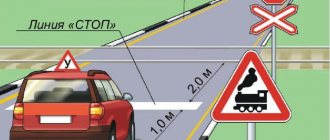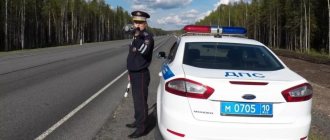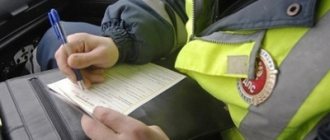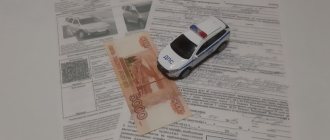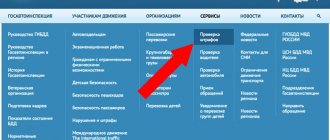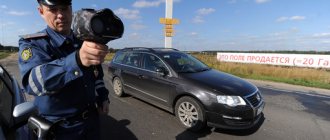Currently, there are more than 11,000 railway crossings on the territory of the Russian Federation. When crossing a crossing, you must strictly follow the established traffic rules, since there is a high probability of an accident with severe consequences.
Dear readers! The article talks about typical ways to resolve legal issues, but each case is individual. If you want to find out how to solve your particular problem , contact a consultant:
+7 (499) 938-81-90 (Moscow)
+7 (812) 467-32-77 (Saint Petersburg)
8 (800) 301-79-36 (Regions)
APPLICATIONS AND CALLS ARE ACCEPTED 24/7 and 7 days a week.
It's fast and FREE !
For non-compliance with the rules, the Administrative Code also provides for punishment for violating drivers. Read on to find out what the fine is for driving at a crossing under a prohibitory signal.
About railway crossings in traffic rules
Rules for the passage of railway crossings contain the term “Railway crossing”:
“Railway crossing” is the intersection of a road and railway tracks at the same level.
The requirements are set out in section 15 of the Rules and consist of five points. All of them will be cited in this article. You can also look them up in the text of the Road Traffic Rules.
Traffic police fines are established by Article 12.10 of the Code of Administrative Offenses of the Russian Federation, which consists of three parts and part four of Article 12.15.
Deprivation of rights from 3 to 6 months or a fine of 1000 rubles
- 12.5. Parking is prohibited: in places where stopping is prohibited;
- …
- closer than 50 m from railway crossings.
12.10.1. Crossing a railway track outside of a railway crossing, entering a railway crossing when the barrier is closed or closing, or when there is a prohibiting signal from a traffic light or the person on duty at the crossing, as well as stopping or parking at a railway crossing - shall entail the imposition of an administrative fine in the amount of one thousand rubles or deprivation of the right to drive vehicles. for a period of three to six months.
Driving through a railway crossing on a red signal
In order, the requirements of the Rules that will be violated.
Crossing a railway track outside a railway crossing - clause 15.1.
15.1. Drivers of vehicles can cross railway tracks only at level crossings, giving way to a train (locomotive, handcar).
Entering a railway crossing when the barrier is closed or closing, or when there is a prohibiting signal from the traffic light or the crossing officer on duty - clause 15.3, requirements 1 - 3.
15.3. It is prohibited to enter the crossing: when the barrier is closed or beginning to close (regardless of the traffic light signal); when there is a prohibiting traffic light signal (regardless of the position and presence of the barrier); when there is a prohibitory signal from the person on duty at the crossing (the person on duty faces the driver with his chest or back with a baton, a red lantern or flag raised above his head, or with his arms extended to the side);
Stopping or parking at a railway crossing - clause 12.4, requirement 2.
12.4. Stopping is prohibited: ... at railway crossings, in tunnels, as well as on overpasses, bridges, overpasses (if there are less than three lanes for traffic in a given direction) and under them;
Clause 12.5 requirements 1 and 3.
For these violations, the driver will be deprived of his license for 3 to 6 months or a fine of 1,000 rubles. It is at the discretion of the inspector to impose a fine or take the case to court. By decision of the court, both deprivation of rights and imposition of a fine are possible. The fact that the case has been sent to court does not mean that the driver will necessarily be left without a driver's license.
Possibility of losing your driver's license
In cases where such violations did not lead to an accident, and also if there are some mitigating circumstances, as a rule, traffic police officers issue a fine. If such actions of the driver caused serious consequences or there are aggravating factors (alcohol intoxication), then the compiled protocol is sent to the judicial authorities, where a decision is made to deprive the driver of his license.
If the offense is committed again within a year, then the driver’s license will be confiscated for 12 months.
Deprivation of rights from 4 to 6 months or a fine of 5,000 rubles
4. Driving, in violation of the Traffic Rules, onto a lane intended for oncoming traffic, or onto tram tracks in the opposite direction, except for the cases provided for in Part 3 of this article, shall entail the imposition of an administrative fine in the amount of five thousand rubles or deprivation of the right to drive vehicles for period from four to six months.
Overtaking at a railway crossing
Entering the oncoming lane when passing railway crossings is prohibited:
Clause 15.3 requirement 8.
In addition, it is prohibited to: drive around vehicles standing in front of the crossing into oncoming traffic;
Clause 11.4 requirement 3.
11.4. Overtaking is prohibited: ... at railway crossings and closer than 100 meters in front of them;
How to pay a fine with a discount
After making a decision to impose a fine for violating traffic rules at a railway crossing, drivers have the opportunity to reduce the assigned amount. To do this, payment must be made within 20 days after receiving the collection. In this case, the amount of the fine is reduced by 50%. It is worth remembering that when the amount of unpaid penalties reaches 10,000 rubles, the traffic police may decide to suspend the driver’s license.
What happens if you don’t pay a fine of 30,000 rubles for deprivation of your rights?
Fine 1000 rubles
2. Violation of the rules for passing through railway crossings, except for the cases provided for in Part 1 of this article, shall entail the imposition of an administrative fine in the amount of one thousand rubles.
Stopping at a railway crossing during a traffic jam
All not mentioned above do not provide for the deprivation of the right to drive for violations when passing a railway crossing. Let's quote section 15 of the Traffic Rules in full and delete the deprivation clauses from it.
15.1. Drivers of vehicles can cross railway tracks only at level crossings, giving way to a train (locomotive, handcar).
15.2. When approaching a railway crossing, the driver must follow the requirements of road signs, traffic lights, markings, the position of the barrier and the instructions of the crossing officer and make sure that there is no approaching train (locomotive, railcar).
15.3. It is prohibited to travel:
- when the barrier is closed or starting to close (regardless of the traffic light signal);
- when there is a prohibiting traffic light signal (regardless of the position and presence of the barrier);
- when there is a prohibitory signal from the person on duty at the crossing (the person on duty faces the driver with his chest or back with a baton, a red lantern or flag raised above his head, or with his arms extended to the side);
- if there is a traffic jam behind the crossing that will force the driver to stop at the crossing;
- if a train (locomotive, handcar) is approaching the crossing within sight.
In addition, it is prohibited:
- drive around vehicles standing in front of the crossing into oncoming traffic;
- open the barrier without permission;
- transport agricultural, road, construction and other machines and mechanisms through the crossing in a non-transport position;
- without the permission of the head of the railway track, the movement of low-speed vehicles whose speed is less than 8 km/h, as well as tractor drag sleds.
15.4. In cases where movement through the crossing is prohibited, the driver must stop at the stop line, sign 2.5 or traffic light; if there are none, no closer than 5 m from the barrier, and in the absence of the latter, no closer than 10 m to the nearest rail.
15.5. When forced to stop at a crossing, the driver must immediately unload people and take measures to clear the crossing. At the same time, the driver must:
- if possible, send two people along the tracks in both directions from the crossing 1000 m (if one, then in the direction of the worst visibility of the track), explaining to them the rules for giving a stop signal to the driver of an approaching train;
- stay near the vehicle and give general alarm signals;
- When a train appears, run towards it, giving a stop signal.
These are violations for which only a fine of 1000 rubles is provided.
At which crossings are there traffic lights?
A railway crossing is the intersection of railway tracks and a road, bicycle or pedestrian road in one plane.
All railway crossings are divided into two large groups:
- adjustable;
- unregulated.
Controlled crossings are equipped with traffic lights, automatic or manual means of blocking the movement of vehicles (pedestrians, bicycles) and employees on duty. A special road sign is installed 50 m from the controlled crossing.
All other types of crossings are unregulated. Such high-risk areas are equipped with the following road sign:
If the visibility area of an unregulated crossing is reduced to the minimum permissible value, then a sign “moving without stopping is prohibited” must be installed at the crossing.
Additionally, railway crossings must be equipped with the following signs:
- approaching the crossing. Signs based on the principle of decreasing lines are installed at a distance of 300 m, 150 m and 50 m from the crossing;
- number of railway tracks at the crossing. The corresponding signs indicate single-track and multi-track railways passing through the crossing.
For safety reasons, the following requirements apply to any move:
- the driver must see the train approaching from each side at a distance of at least 50 m;
- the train driver must see the intersection with the roadway at a minimum distance of 1000 m;
- the intersection of the road and the railway track must be made at an angle of 90º. If local conditions do not allow moving at a right angle, then the angle can be reduced to 60º;
- markings prohibiting overtaking must be placed on the roadway (solid white line);
- all crossings must be illuminated, and the level of illumination of the dangerous area depends on the intensity of traffic of trains and road transport.
Warning signs for a railway crossing with a barrier are discussed in the article: sign for a railway crossing with a barrier. Read about violation of railway crossing rules here.
Features of qualification when stopping at a crossing
Those who were attentive noticed seemingly contradiction in imposing responsibility for stopping at a crossing.
Stopping is prohibited: at railway crossings...
Provides for the deprivation of rights, but the prohibition to stop in a traffic jam is not deleted from the quotation of the 15th section.
It is prohibited to drive to a crossing: if there is a traffic jam behind the crossing that will force the driver to stop at the crossing;
It is not difficult to guess in which direction such a “contradiction” will be interpreted by the inspector. He will write in the decree the deprivation part 1 of article 12.10. An untrained driver will agree to the violation.
Remember, stopping traffic in a traffic jam is not a stop . When you are issued such a decree, do not agree and demand that a protocol be drawn up.
For more information about stopping and stopping, see this material.
Reclassification of such a violation will not be difficult. If the inspector is told before compiling the material that his classification of the violation is incorrect, then he will most likely issue a fine corresponding to the violation, that is, only 1000 rubles without the alternative of deprivation.
The nuances of imposing a fine for driving through a prohibiting signal
On roads with heavy traffic of trains and vehicles, there is a chance of falling into a trap and getting a fine for driving through a crossing at a prohibitory signal. How it works?
As you know, there is no warning signal at the traffic light at the railway crossing. And in heavy traffic, the red light may turn on when your car has already crossed the visibility zone of the traffic light. Traffic lights work synchronously.
On the opposite side of the crossing, an accident patrol with photo recording is located and takes pictures of the car entering the crossing and the red signal from the oncoming direction. The camera angle is set in such a way that it is not visible whether there is a car before or after the traffic light. From which it is concluded that the passage was carried out in response to a prohibitory signal.
Photo recording at a railway crossing
with a narrow viewing angle can save you from falling into such a trap . Wide-angle recorders “see” much wider than the human eye
